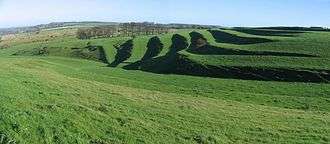Lynchet

A lynchet is an earth terrace found on the side of a hill. Lynchets are a feature of ancient field systems of the British Isles. They are commonly found in vertical rows and more commonly referred to as 'strip lynchets'. Lynchets appear predominantly in Southern Britain and many are in areas close to Iron Age forts and other earthworks, including later Roman earthworks and earlier barrows from the Neolithic and Bronze Age periods. The size, location, spacing and number of rows of many strip lynchets indicates that many were man-made. It is most likely that lynchets were dug to maximise the use of land for agriculture, although they may have had other, ceremonial uses.
In the village of Loders, Dorset, lynchets form a terraced band structure similar to an amphitheatre overlooking the village.

Lynchets form part of the Conservation area of neighbouring village Uploders and where they apparently form old hillside field systems in close proximity to an iron age fort and hill-top barrows. Maps from the 1800 indicate that cider orchards were planted on some lynchets in that area.
The traditional theory on the formation of lynchets is that they may form naturally on the downslope of a field ploughed over a long period of time.[1] The disturbed soil slips down the hillside to create a positive lynchet while the area reduced in level becomes a negative lynchet.
The word is the diminutive form of lynch, now rarely appearing in the English language, indicating an agricultural terrace.
See also
References
- ↑ "National Monuments Record Thesauri". English Heritage. Archived from the original on 18 July 2011. Retrieved 14 April 2010.
| Wikimedia Commons has media related to Lynchets. |